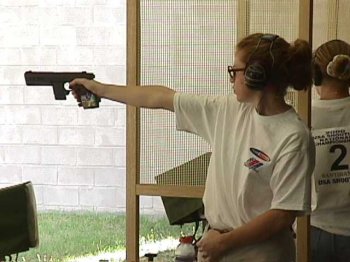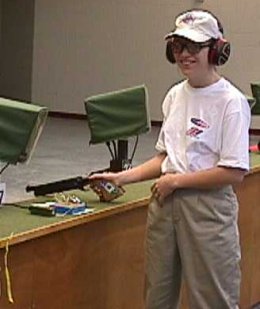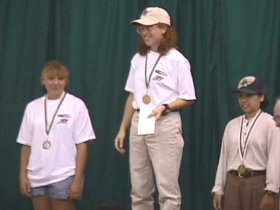INTERVIEW WITH JANINE BOWMAN
Janine Bowman blitzed the field at the 1998 USA Shooting National Championships in Sport Pistol to easily win a place on the Olympic Team headed for Sydney. We spoke to her in Atlanta just after her win.
When did you start shooting?
I started shooting in 1992 at the Coast Guard Academy. It was my second year there. I was originally in the Drum and Bugle Corps. We were required to be in two sports activities a year, and the Drum and Bugle Corps was one, and I wasn’t having fun so I wanted to quit. I didn’t know what other sport or activity to take up. My best friend was on the pistol team, she was the only female at the time. It took her two weeks to convince me to do it. She said, “Join the team, we can go to matches together because they don’t have to pay for another hotel room. It’ll be fun!” I thought, “I can’t shoot guns, I’m afraid of guns.” But she convinced me, and I started shooting at the Academy.
Were you shooting International or Bullseye?
International for those first few months, and then I shot Bullseye.
I guess you’ve shot both since?
I have shot both since, but I haven’t done as much Bullseye. I’d shoot at Camp Perry for the military matches.
Who was your biggest shooting influence?
I got some great coaching from Joseph Brubaker, he was a Lieutenant Commander and a lawyer at the Academy. He was an excellent coach. I didn’t have any bad habits, he taught me everything I needed to know.
Is this your first National Title?
It’s my first open title. In my first year of shooting at the Collegiate Nationals, five months after I started I won the Womens Air Pistol event. Then I won it again the next year, medaled in Sport, and then the year after that I won Sport and medaled in Air and Standard Pistol.
What type of pistols do you shoot?
In Air Pistol I shoot a Steyr. In Sport I shoot a Hammerli 280.
Do you have any preferences for brands of ammo?
For 22 I like Eley. It’s getting up there in price so I might have to shift to something different. If I get wealthy then it won’t be an issue. I like Eley, I’m happy with that. I shoot Finale Match for Air Pistol. I haven’t tried anything else. But when I practice I shoot Daisys.
Do you batch test?
I’ve tested seventeen types of 22. It definitely likes Eley. The air pistol, it has been batch tested in Europe at a World Cup last year.
How long have you been on the US Team?
Two years. For 22. I haven’t made the Air Pistol team yet, but I’m working on it.
Coming into a match like this, how often do you train?
Six days a week, two hours a day. That’s my aim and I keep as close to it as I can.
What percentage would be live fire versus dry fire?
For every live fire shot, two dry fires. But there’s a couple of reasons for that. For one I have to pay for my own ammo.
But you do see a lot of benefit in dry fire?
Absolutely. Dry firing has brought me a long way. My scores have gone up a good twenty points thanks to dry firing.
What sort of trigger do you like? Do you prefer a crisp or roll release?
I prefer crisp.
When you’re shooting Sport, do you preload your trigger as you wait for the green light in the Rapid Fire stage?
No. As soon as I hit the target then I start taking up weight. By the time I get to the middle it’s ready to go.
For precision do you shoot six o’clock or sub-six?
Sub-six.
Somewhere around the 4 or 5 ring?
The same amount of light space that I have between the sides.
 What do you say to yourself as you’re shooting?
What do you say to yourself as you’re shooting?
“Trust your hold”. I say that all the time, over and over during the match, when I’m really nervous and my palms are sweating. I see a lot more movement than I’ve ever seen before when I’ve got the gun up, I say, “Trust your hold”.
Does that mean that you’re trying to get the shot completed in the same time frame as normal rather than try to wait for the sights to look better?
No. Basically I look hard at that front sight and I keep loading the trigger, the same pressure until it goes off, and I just have to trust that my hold was good. I don’t do it every time like that, but that’s what I work on. I treat every match as training. I work on my hold, work on trusting it.
This is from a discussion I’ve had with some of our readers; do you have any idea when your shot’s going to break?
No idea. I prefer it like that.
What’s your funniest shooting experience?
To be honest, it was what I found out reading a discussion board that Scott (Pilkington) sent me, shooting against a certain Mr Warren Potter in air pistol and beating him by one point, and his reaction to it. Your reaction was hilarious. I’ve shot against men before and they’ve taken it very well. That was my most entertaining experience.
(At Camp Perry last year Janine shot in the Air Pistol Grand Prix, which was an open 60-shot match. Because I was egged on by a certain character from Rhode Island who shall remain nameless but will not escape justice, I was led to believe that Janine had shot BOTH a 40 shot womens event as well as the 60 shot match. This led to my threat to turn up at next year’s event to shoot the womens event in drag. There is, of course, no 40 shot match and I was “fished in” beautifully. – WP)
I’m glad.
That was so cool.
How do you handle match pressure?
I try to treat each match as training. I focus on what I’m supposed to be doing. While I’m training, I have the tendency to do better. So I don’t think about scores, I make sure I’m sighted in and I work on looking at that front sight, squeezing the trigger until the gun goes off. Just working on the basics. It’s not easy, but that’s what I strive to do each match.
You would have a shot sequence? You go through the same routine for each shot?
I take a deep breath, and relax. Then I try to visualize the shot before I take it. I imagine taking a perfect 10.9 and then go ahead with the shot.
At what stage would you cancel a shot?
As soon as a thought pops into my head the gun goes back down. If I start thinking about things, then I’m not watching the front sight, I’m not thinking about the trigger pull. That’s one of them. Another one is if I see an awful lot of movement and it doesn’t feel right, it goes down. If I’ve been holding a really long time, it goes down.
And it takes a lot of discipline to do that. Yes. There are times I take up to eight attempts to get a shot off.
Is that in both Sport and Air? Sport and Air are a little bit different, because I know I have more time in Air Pistol so I take more time. In Sport Pistol I take three or four lifts before I get a shot to break if I’m having a lot of trouble, but it’s not every shot. It’s only one or two, then I’m okay, then another shot I need to work on, and then I’m okay, and so on.
You shot an excellent Rapid Fire in Sport, a 295.
Yes
Do you train much physically to have the stamina for that part of the event?
When I train for Sport I put an hour into Precision and an hour in Rapid, and I don’t take many breaks in Rapid Fire. So I do about three times as many lifts as I would in a normal match. So physically it’s a piece of cake. It’s just a matter of having the right mentality to do it. I have to shift it from Precision. In Rapid Fire I’m more aggressive, and the more aggressive I am, the more aggressive I am on that trigger, still looking at that front sight, the better it goes.
How did you cope with the long breaks during the match? (There were long delays due to technical problems in the Rapid Fire sequence at the 1998 Nationals.)
I got angry. I used that, and focused that anger down range, because it helped the aggression. The biggest thing I have to work on in Rapid Fire right now is my lift. I want it to come straight up, slow down at the right moment, and when it stops the gun goes off. That’s the plan. That’s what I work on, and I know if I don’t do it, when I get the first shot off, I say, “Oh come on, you can do better than that.” It used to be five shots, if one was bad they were all bad. Now if one’s bad the rest of them are where I want them to be. I can see it and I know what I’m doing.
And the aggression helps?
The aggression is very important right now for me. Overkill is possible, I mean it is possible to get too aggressive and then you start getting spastic on the trigger, so it needs to be a controlled aggression.
Cold and calculating?
Right.
What advice would you give somebody just starting out in the sport?
The same advice that I was given. To build endurance. I had a five pound weight, which I still have, and I still use every day for about ten minutes. I just hold the weight out. You can do it sitting or standing, just hold it out as if you were shooting, and when your arm gets tired, put the weight down. At the academy during my first year I had trouble staying awake in a couple of my classes because I wasn’t getting enough sleep. So what I did, I’d have to stand up in the back of the room. I took one of the big heavy books and I’d hold the book out while I was listening. These were during discussions that didn’t require note taking. So I’d stand in the back with the book. They’d all look at me funny, but after a while they stopped. But your endurance, it can be worked on quickly.
Do you keep a diary?
I used to. I’m trying to get back into that, because it helps too in maintaining focus. If I’m having trouble I sit down and I write down what I need to do. I stay away from “don’t”s. I focus on “do”s.
What advice would you give juniors?
I was an older junior when I started. Have fun, enjoy the sport. If you don’t enjoy it, you probably won’t keep it up.
